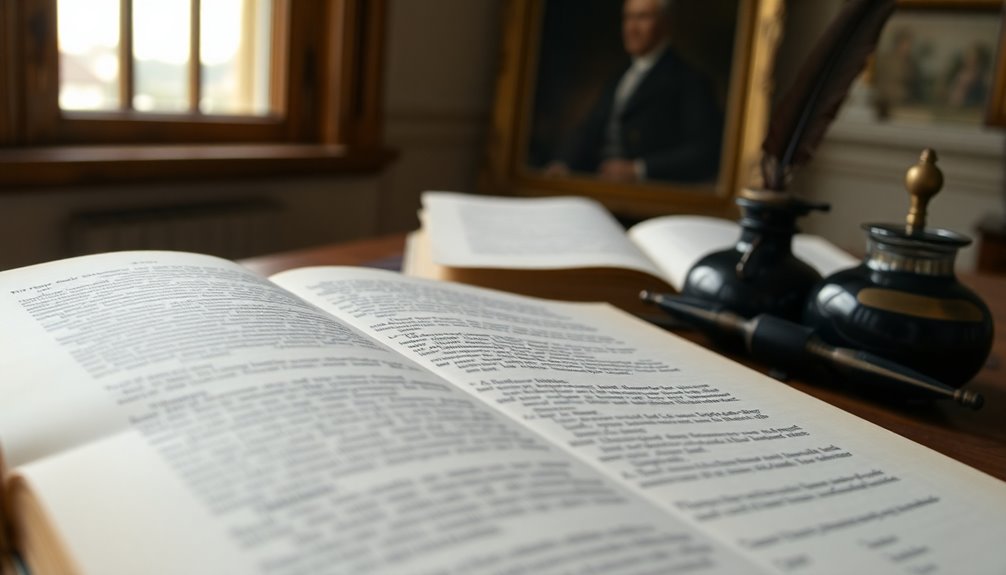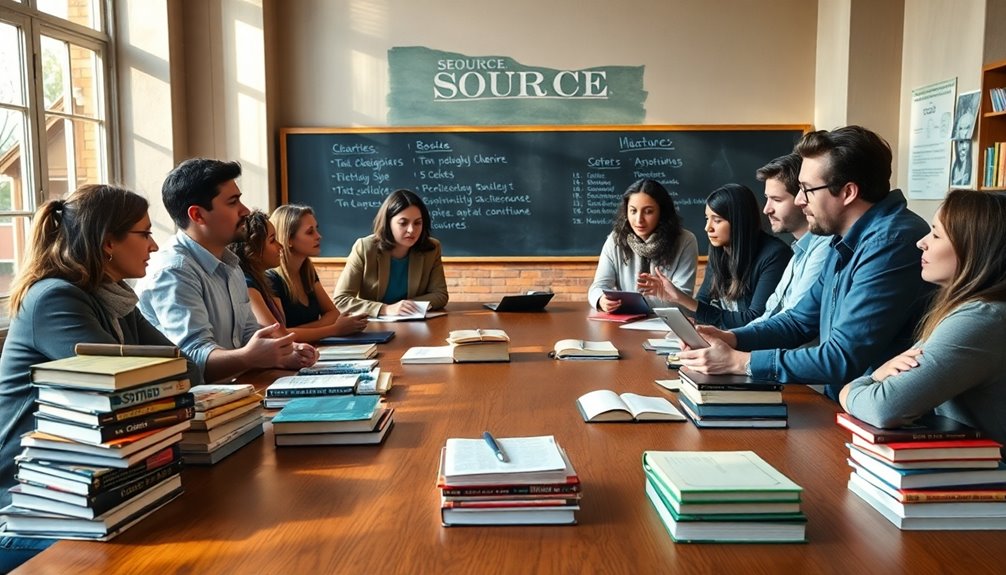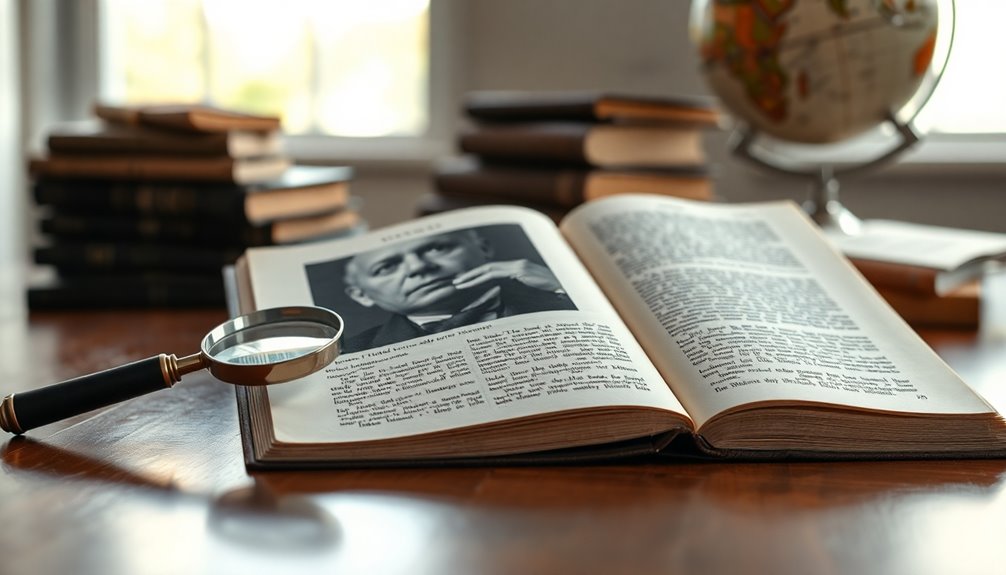A biography is usually considered a secondary source. It gathers and interprets information from primary sources like diaries, letters, and interviews, providing a narrative of someone's life. It's important to understand that context matters; sometimes, a biography can function as a primary source, especially if it includes firsthand accounts from the subject, like in autobiographies. These works synthesize various materials to enrich understanding, but they primarily analyze rather than present original evidence. If you're curious about how context affects these classifications or want examples, there's more to explore on this topic.
Key Takeaways
- Biographies are primarily considered secondary sources, as they interpret and analyze primary sources rather than providing firsthand accounts.
- Autobiographies, however, are primary sources, as they offer the author's personal narrative and direct experiences.
- The classification of a biography can shift based on context, such as its relevance to significant historical events.
- Biographies compile information from various primary sources, providing nuanced perspectives on a subject's life.
- Contextual factors, including the author's intent and emotional state, can influence whether a biography is viewed as primary or secondary.
Understanding Primary and Secondary Sources

When you plunge into research, understanding the difference between primary and secondary sources is essential. Primary sources are original documents or firsthand accounts created by individuals directly involved in an event. Think of things like historical documents, diaries, letters, and interviews. You'll also find creative works like poems and artworks, as well as multimedia like photographs and videos. These sources serve as the raw material for your research. Additionally, art objects can also be considered a form of primary source, enriching the variety of materials available to researchers.
In contrast, secondary sources analyze and interpret primary sources. They provide context and commentary, often relying on the firsthand information found in primary sources. A document can serve as a primary source in one context but become a secondary source in another—depending on how it's used.
To find primary sources, explore libraries, museums, and online databases. Secondary sources can guide you to primary ones through their citations. Don't forget to properly cite any primary sources you use, following style guidelines like MLA or APA. By grasping these distinctions, you'll enhance your research skills and develop a deeper understanding of your subject matter.
The Nature of Biographies

When you think about biographies, it's important to recognize that they usually serve as secondary sources, interpreting someone else's life. While they provide valuable context and insights, they rely on existing information rather than original documents. However, there are exceptions where a biography might offer unique perspectives that could be considered primary in specific contexts. For instance, a biography often includes primary sources such as interviews with the subject's family and friends, adding depth to the narrative.
Biography as Secondary Source
Understanding the nature of biographies reveals their role as secondary sources that offer insights into a person's life through the lens of another. Written by someone other than the subject, biographies provide a third-person narrative that requires extensive research and fact-checking to guarantee accuracy. They cover the entire scope of a subject's life, detailing key events from birth to the present, including childhood, education, relationships, and career milestones.
As you read a biography, you'll notice it highlights significant experiences that shaped the subject's existence. These accounts are organized either chronologically or thematically, giving you a well-rounded description of their life. Biographers use various sources, such as interviews, letters, diaries, and even photographs, to piece together their narratives. For historical figures, primary sources and accounts from friends or family are often employed to enhance the narrative.
Written in a formal and objective tone, biographies aim to recreate the world the subject lived in while analyzing their experiences. This approach allows you to grasp the subject's humanity and uncover valuable life lessons through the author's interpretations. Consequently, biographies serve as essential secondary sources in understanding an individual's life story. Additionally, they often highlight the complete life story of the subject, which is a defining characteristic of biographies.
Contextual Exceptions Explained
Biographies primarily function as secondary sources, but there are important exceptions that can reframe their role. For instance, if you're reading an autobiography, you're engaging with a primary source. These firsthand accounts provide direct insights into the author's life and experiences, making their reflections invaluable for research. Similarly, if a biography includes letters or diaries, it can serve as a primary source for studying the subject's relationships with historical figures.
When analyzing an author's literary or artistic style, a biography can also act as a primary source. Original writings or drafts included in the biography offer a glimpse into the creative process and the author's intent. This context is critical for understanding their artistic choices and development. Additionally, primary sources often lack explanatory context, which can evoke a sense of time and place that enhances the analysis of the subject's life.
Moreover, if you're examining historical events that the subject participated in, personal accounts within the biography can provide firsthand perspectives. Speeches, letters, or other documents from that era enhance your understanding of the subject's role in significant events. In these cases, biographies shift from secondary to primary sources, enriching your research and offering deeper insights into the lives and contexts of their subjects.
When Biographies Are Secondary Sources

When you consider biographies, it's important to recognize that they're often third-party accounts. The biographer interprets and analyzes the subject's life, relying on various sources rather than firsthand experiences. This interpretative role is what classifies most biographies as secondary sources. However, there are exceptions, such as when a biographer writes about themselves, which qualifies as a primary source.
Third-Party Accounts Explained
A biography often serves as a third-party account, providing insights into a person's life based on information gathered from various primary sources. Unlike primary sources, which offer firsthand accounts, biographies are crafted by authors who didn't experience the events directly. This makes them secondary sources that analyze and interpret the subject's life.
Here are some key characteristics of biographies as secondary sources:
- Compiled Information: They pull together details from diaries, letters, and other original materials.
- Multiple Perspectives: Biographies can present different interpretations of the subject's life and events.
- Historical Context: Often written long after the events, they provide hindsight and context for understanding the subject.
- Analysis and Interpretation: Authors synthesize the primary sources to draw conclusions, offering added value to existing knowledge. Additionally, biographies often reflect the evolving societal interpretations of history, which can change as new secondary sources emerge.
Biographer's Interpretative Role
The role of a biographer is essential in shaping our understanding of a subject's life, as they weave together narratives from various sources to create a cohesive story. Biographers analyze and interpret the subject's actions, using primary sources like diaries and letters to build a rich narrative. They add context and historical background, often incorporating their insights and perspectives on the subject's significance. In many cases, biographical works are considered secondary sources because they interpret and analyze primary materials rather than serve as original documents themselves.
Here's a quick look at how biographers interpret lives:
| Aspect | Description |
|---|---|
| Analysis and Interpretation | Biographers reveal patterns and trends in the subject's life. |
| Use of Primary Sources | They rely on original documents and firsthand accounts. |
| Expertise and Objectivity | Specialists provide deeper understanding, though biases may exist. |
| Accessibility | Biographies make complex information more readable. |
| Contextualization | They situate the subject's life within broader frameworks.
Exceptions to the Rule

Biographers often navigate a complex landscape where their work can shift between primary and secondary sources. Understanding exceptions to the rule can clarify when a biography might be classified as a primary source. Here are some key exceptions to take into account:
- Biographer as Subject: If you're writing about your own life, your biography acts as a primary source since you have direct knowledge of the events.
- Context Matters: A biography can serve as a primary source when used to analyze the biographer's life or work, but might be secondary in other contexts. Additionally, the emotional state of the biographer can influence how they present events, mirroring aspects seen in individuals with Borderline Personality Disorder.
- Inclusion of Original Materials: When a biography contains original documents or first-hand accounts, it can provide primary source insights into the subject's life and historical context.
- Field-Specific Uses: In fields like intellectual history or cultural studies, biographies can be primary sources if they reflect significant events or ideas relevant to that time. Additionally, understanding the nature of sources is vital for effective historical research, as the classification of a biography may be context-dependent based on its usage.
Recognizing these exceptions helps you better understand how to interpret biographies in your research, ensuring you classify sources correctly based on context and content.
Examples of Source Classifications

Understanding how to classify sources is fundamental for effective research. By distinguishing between primary and secondary sources, you can enhance the validity of your work. Here's a quick overview of examples from various fields:
| Type of Source | Primary Sources | Secondary Sources |
|---|---|---|
| History | Official reports, speeches, letters | Articles that analyze historical events |
| Science | Original research publications | Scholarly articles interpreting data |
| Humanities | Novels and plays from the studied era | Textbooks summarizing key concepts |
Primary sources include firsthand accounts or original materials, such as photographs or original research. In contrast, secondary sources provide interpretation or analysis, like biographies or academic articles. Understanding these distinctions helps you choose the right materials for your research. Moreover, primary sources are key for displaying original thinking and new discoveries, which can significantly enrich your analysis. By using this classification, you can guarantee that your findings are grounded in reliable evidence, allowing you to build a stronger argument in your work. Always think critically about the sources you use, as they form the backbone of your scholarly exploration.
Contextual Factors in Classification

Context shapes how we classify biographies, influencing whether they're seen as primary or secondary sources. Several factors come into play when making this determination:
- Historical Context: If you're studying the biographer or the period they lived in, the biography can be a primary source.
- Author's Role: Depending on whether the author is the subject or an observer, the biography's classification may shift.
- Direct Knowledge: If the biographer had firsthand experience with the subject, the biography is likely a primary source.
- Time of Creation: A biography written during the events it describes often qualifies as a primary source.
These factors illustrate that the classification of a biography isn't fixed. It can change based on the specific context of your study. For instance, in historical analysis, a biography might serve as a secondary source unless it offers original insights. Similarly, in literary studies, it can transform into a primary source if you focus on the author's writing style. Understanding these contextual factors is essential for accurately classifying biographies and utilizing them effectively in your research. Additionally, the classification can depend on the intended use of the source, as this influences how researchers approach the biography in their analysis.
The Value of Primary Sources

Primary sources hold immense value in research because they provide direct access to original materials and firsthand accounts. Unlike secondary sources, which interpret or analyze information, primary sources present the evidence you need to draw your own conclusions. These original materials, created during or shortly after events, minimize the risk of distortion and misattribution. In research, understanding source classification is critical for ensuring accuracy and relevance in your findings.
Here's a quick overview of the different types of primary sources and their significance:
| Type of Primary Source | Examples |
|---|---|
| Textual | Diaries, letters, and laws |
| Visual | Photographs and videos |
| Auditory | Speeches and interviews |
| Data | Original research and datasets |
These sources are essential in various fields. In the humanities, they include writings by influential thinkers. In social sciences, they consist of original data, while in natural sciences, they report groundbreaking findings. By utilizing primary sources, you guarantee academic integrity and credibility in your work, allowing you to explore original thoughts and evidence without the filter of interpretation. So, when conducting research, prioritize primary sources to enrich your findings and insights.
Frequently Asked Questions
Can I Use a Biography as a Primary Source for My Research?
You can use a biography as a primary source in rare cases, like when the biographer's personal insights are included. However, generally, it's considered a secondary source since it interprets someone else's life.
What Are Common Examples of Primary Sources in Biographies?
Did you know that 70% of historians consider personal letters essential for understanding a subject? In biographies, primary sources include diaries, photographs, and original manuscripts, offering deep insights into the author's life and experiences.
How Do I Determine if a Biography Is Authorized or Unauthorized?
To determine if a biography is authorized, check for direct involvement from the subject, endorsements, or collaboration with family and friends. Look for explicit statements in the introduction or acknowledgments confirming the subject's approval.
Are Autobiographies Considered Primary Sources?
You might think autobiographies are just stories, but they're actually primary sources. They offer firsthand insights and experiences, creating an authentic connection to the author's life, unlike the interpretations found in biographies.
What Criteria Should I Use to Evaluate a Biography's Reliability?
To evaluate a biography's reliability, check the author's credentials, the use of primary sources, potential biases, and peer reviews. Balancing these factors helps you determine if the biography presents an accurate and credible portrayal.










